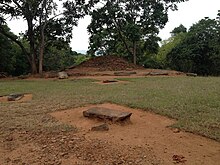| Keheliya Raja Maha Vihara | |
|---|---|
| කැහැලිය රජ මහා විහාරය | |
 The dilapidated Stupa and other ruins The dilapidated Stupa and other ruins | |
| Religion | |
| Affiliation | Buddhism |
| District | Monaragala |
| Province | Uva Province |
| Location | |
| Location | Handapanagala, Wellawaya |
| Country | Sri Lanka |
| Geographic coordinates | 06°39′55.8″N 81°07′37.4″E / 6.665500°N 81.127056°E / 6.665500; 81.127056 |
| Architecture | |
| Type | Buddhist Temple |
Keheliya Raja Maha Vihara (Sinhala: කැහැලිය රජ මහා විහාරය) is an ancient Buddhist temple in Monaragala District, Sri Lanka. The temple is located in Handapanagala village approximately 11 km (6.8 mi) distance from Wellawaya town. The temple has been formally recognised by the Government as an archaeological site in Sri Lanka. The designation was declared on 22 November 2002 under the government Gazette number 1264.
The temple

Located in Neluwagala Grama Niladari Division, the temple has been built on a small rock plateau close to the Handapanagala reservoir. The top of the rock plain is occupied by an ancient Stupa which is accessed by few steps, curved on the rock surface. The Stupa is now in almost dilapidated state, resembling only a mound of earth bounded with few rock boulders. Adjoining to the Stupa, a ruined image house is identified with number of other stone works including altars, monoliths, Balustrades (Korawak Gal), stone bases, Yantra stones and rock inscriptions. The rock inscriptions have been curved on the surface of the rock plateau and resemble early Brahmi scripts. The lower terrace, situated at the north of the Stupa contains large number of ruined stone columns including a pillar inscription. The ruins are believed to be belongs to the 3rd century BC of the King Devanpiya Tissa period (307 BC – 267 BC).
References
- "Protected Monument List 2012-12-12 (In Sinhala)" (PDF). Department of Archaeology. 12 December 2012. Archived from the original (PDF) on 23 November 2018. Retrieved 29 January 2018.
- "Gazette". The Gazette of the Democratic Socialist Republic of Sri Lanka. 1264. 22 November 2002.
- ^ "Uma Oya Multipurpose Development Project- Final Report – Nov 2010#Keheliya Raja Maha Viharaya" (PDF). EJUSTICE. 20 November 2010. p. 185. Archived from the original (PDF) on 20 September 2018. Retrieved 30 January 2018.
The archeological remains of a stupa and image house in the rocky plain and two buildings with stone columns near it is believed to be belongs to the 3rd century BC of the King Devanpiyatissa period. The two inscriptions seen in the area has early brahmiyan letters. The area is an archeological reserve
External links
- Remnants from the past around Wellassa#Kahaliya Raja Maha Viharaya Archived 1 February 2021 at the Wayback Machine